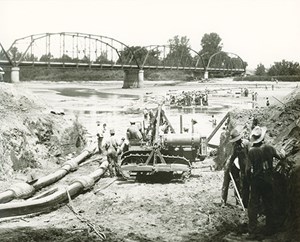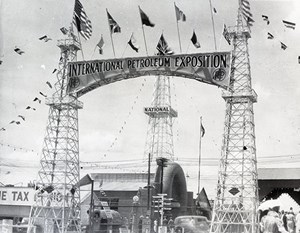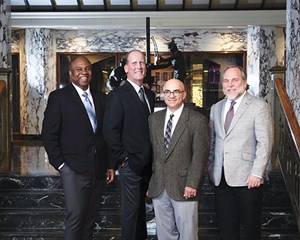January 2023 Vol. 78 No. 1
Features
Pipe Liners Club of Tulsa Celebrates 75th Anniversary, History of Service
(UI) — The Pipe Liners Club of Tulsa (PLCT) recently celebrated its 75th anniversary. Tulsa’s Mayor G. T. Bynum marked the occasion with a proclamation acknowledging PLCT’s many contributions to the city’s economy and culture.

In addition to focusing on the organization’s longevity and long-time benefit to the city’s economy, the proclamation honored the pipeline construction industry for its ongoing efforts to educate, train and grow the next-generation workforce by awarding scholarships to aspiring young students.
The scholarship program awards $150,000 annually and is funded by PLCT’s 400-plus membership through events such as golf and sporting clay tournaments. Members of the organization include a wide range of industry professionals from companies such as Williams, ONEOK, Magellan and many area pipeline construction, service and manufacturing companies.
The mayor’s proclamation came during what has become known as Pipe Liners Week in Tulsa. It is a special recognition of an industry that remains a significant economic driver in a city once known as the “Oil Capital of the World.”
PLCT’s long history began in 1947. With World War II in the rearview mirror, the industrial sector of the United States was transitioning from wartime manufacturing of weaponry to producing consumer products on an unprecedented scale. This would usher in a peacetime economy of prosperity for the United States and, more specifically, the petroleum industry as a whole.
Automobiles, gas stoves, home heating furnaces and other products requiring petroleum were being absorbed by a robust economy fueled by an affluent middleclass. This would bode particularly well for the pipeline industry. The decades following this uniquely historic period would produce thousands of miles of pipelines crisscrossing the country in order to keep up with the increasing demand for energy.
History
Against this postwar backdrop, a small, but visionary group of pipeline industry entrepreneurs decided to form a professional organization called Pipe Liners Club of Tulsa and began conducting meetings in 1948 at various locations around the city.
The first elected officers were: President J.L. Cahill of Continental Pipe Line Co.; Vice President P.L. Reichard and Secretary J.D. Jones, both of Gulf Refining Co.; and Treasurer F.C. Whiteside with Interstate Oil Pipe Line Co. There were four directors, F.V. Cook, G.P. Jennings, Samuel C. Phelps and J.F. Nickel.
During the first meeting, six presentations were given ranging from a talk on control valves by John E. Green to a movie titled Electricity and Oil Industry sponsored by General Electric. These presentations set the stage for what would define the organization’s goal: providing relevant, timely and pertinent information for its membership. Thus, the cornerstone was laid for a professional organization that would serve to strengthen and elevate a vital and prospering industrial sector of America.
In the decades that followed, the pipeline industry experienced phenomenal growth nationwide in both size and technical advancements, making professional organizations focused on the continual improvement of the multifaceted industry increasingly relevant. By virtue of being the first of its kind, PLCT became the model for such organizations.
Beginning in Tulsa and spreading across the industry, professional organizations grew commensurate with the growth and technical advancements of the pipeline industry. Like PLCT, these professional groups consistently played a major role in keeping membership informed of the ever-changing nature of the industry.
In the 1970s and 1980s, Tulsa witnessed the beginning of what some describe as the great petroleum industry diaspora. After more than a half century of drawdown from the state’s oil reserves to fuel America’s burgeoning industries, and with no seaport available to a landlocked, prairie city, Tulsa watched helplessly as oil industry consolidation began peeling away some of the many oil companies instrumental in building the robust metropolis on the plains.
With offshore drilling coming into its own in the Gulf of Mexico and Houston offering bustling seaports and access to what was fast becoming the global oil market of today, many major oil companies moved their headquarters out of Tulsa.
Anchored in Tulsa
Not so with PLCT. The organization remained rooted in Tulsa. Longtime supporter of the organization, former Tulsa mayor, and CEO of Keener Oil & Gas Company, Dewey Bartlett, Jr. believes in spite of the cyclical, up and down nature inherent in the pipeline industry, the club has found ways not only to survive but to thrive.

“There’s no better place than Tulsa for an organization with such a storied past,” Bartlett pointed out. “We have an energy-based legacy here in the state and in the city of Tulsa with great companies able to keep an organization like PLCT vibrant and relevant.”
From the beginning, the overarching goal of the organization is best stated in what has become its mission statement: “The Pipe Liners Club of Tulsa is dedicated to the advancement of pipeline engineering, maintenance and operating practices for the benefit of members and the industry.”
To that end the organization has continued to serve a membership consisting of operational, service and manufacturing companies, with updated information on subjects ranging from technological advancements to best practice safety protocols. The advent and impact of high-end technology has made staying ahead of the information curve more challenging than ever.
Like many employers these days, the pipeline industry finds itself in continuous competition for talented youth to replace an aging population of workers in every relevant field in the industry, including equipment operators, engineers and administrators. The scholarship committee was formed to address this ongoing challenge.
The program began in 1955 with a letter from the scholarship committee to R.L. Langenheim, dean of engineering at the University of Tulsa’s College of Petroleum Sciences and Engineering, offering a scholarship in the amount of $350 for the 1956-57 school year. From there the fund grew in accordance with the need for skilled employees and the rising cost of higher education. To date, the fund has provided more than $2.5 million benefiting some 2,500 students.
Last year’s PLCT’s president, Terry Flynn of Tulsa Rig Iron, understands how important recruiting talent can be to an industry that demands a wide spectrum of work skills.

“Like all industries, pipeline construction, service and manufacturing are faced with the challenge of continually replacing its workforce with well-prepared workers at all levels. I’m proud to be a member of an organization that not only understands this challenge but consistently and collectively invests in human capital.”
This year’s club president, Shawn Lowman of Pipeline Equipment Solutions, believes PLCT’s scholarship program further illustrates the organization’s longtime commitment to education as a means of maintaining the highest level of industry professionalism.
“We understand how rapidly the pipeline industry has advanced over the years and the importance of keeping abreast of changes in our industry,” he said. “Ongoing education is how we maintain best-practice methodology throughout the pipeline industry. We continue to learn from the past and prepare for the future.”




Comments